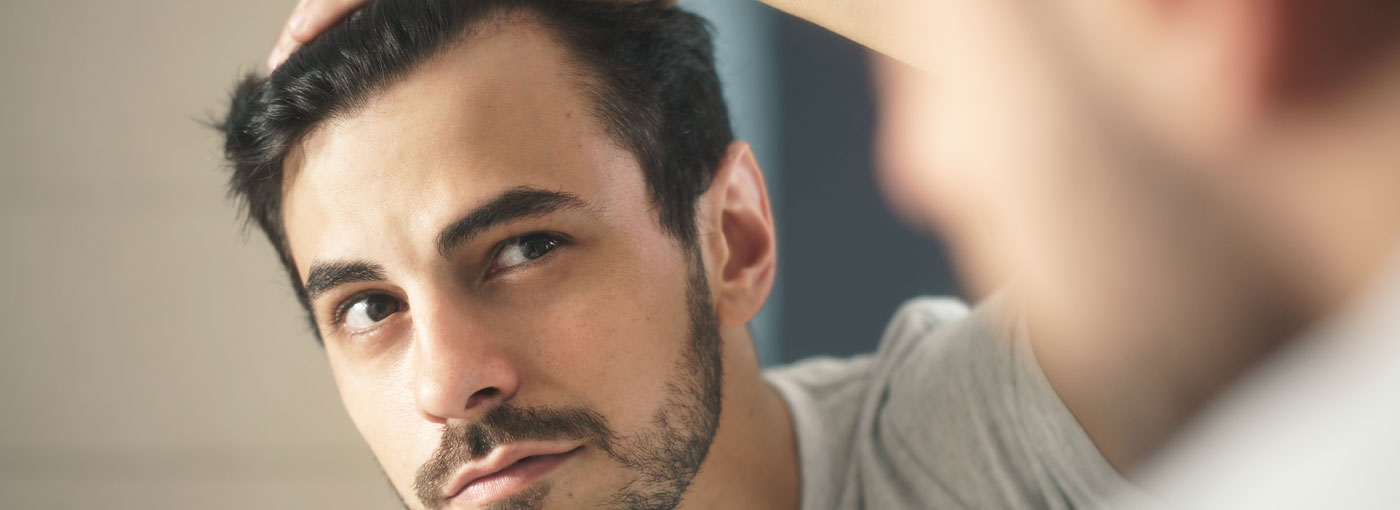
What is alopecia and what types of alopecia are there?
Everyone knows the term baldness as synonymous with hair loss, but the medical term for the condition is alopecia.
Although it usually affects more men than women, both sexes can suffer from it. For women especially, it can cause mental health problems related to the loss of self-esteem and self-confidence.
What is alopecia?
Alopecia or hair loss is a very common medical problem suffered by many people in the world. It is more than a purely aesthetic issue; it’s considered a disease by the World Health Organization (WHO). People normally lose between 100 and 120 hairs a day; Alopecia is when hair loss exceeds this number.
What types of alopecia are there?
There are up to 6 known types of alopecia, which are: androgenetic, areata, fibrosing, diffuse, scarring, and universal.
Types of alopecia
- Androgenic, also called male-pattern baldness, is the most common. It usually occurs more or less from the age of 40.About 50% of men and 10% of women suffer from it.The cause is mainly genetic, though it can also be hormonal. This genetic cause was originally attributed to maternal genetics; however, it has been shown to be unpredictable since genes are not inherited in exact proportions and are a combination of different family members, i.e., polygenic inheritance. In the case of the hormonal component, there is a phenomenon in which male hormones or androgens act on hair follicles genetically predisposed to the condition. Thus, they progressively cause the hair follicles to atrophy until the hair disappears completely. With women, the hair loss is diffuse, since not all of it falls out and there is no receding hairline like there is with male pattern baldness.
- Alopecia areata is the second most common type of alopecia. This type of hair loss is patchy to begin with, though it can spread to the entire scalp or even to the rest of the body. Usually, this type of alopecia disappears, and the hair grows back, although these patches may reappear if there is a relapse. It is a condition that is usually related to autoimmune diseases such as celiac disease, diabetes, or arthritis.
- Fibrosing alopecia, better known as frontal alopecia, usually affects more women than men. Little is known about this type of alopecia, including its cause. It is known that it may be related to menopause. Fibrous alopecia mainly affects the area of the hairline, forming a band that gradually moves backwards.
- Diffuse alopecia, also called effluvium, is a reversible type of hair loss. The intensity can vary, but it covers an area of the scalp where the hair is falling out.
- Scarring alopecia, as its name suggests, is a type of hair loss caused by a scar. This can result when hair follicles have been destroyed, preventing the appearance of new hair in the area.
- Universal alopecia causes baldness due to an autoimmune disease that ‘attacks’ the hair follicles, preventing hair from being produced. With this type of alopecia, the patient’s antibodies attack the hair follicle, totally eliminating it. It is important to clarify that universal alopecia is a subtype of alopecia areata. The only difference is that it is more aggressive.
Undoubtedly, alopecia areata is one of the most serious forms of hair loss.In this type of alopecia, the immune system attacks the hair follicles; that is, it attacks the structures of the skin that produces the hair.
To find out what type of alopecia you have, it’s best to go to a specialist who will be able to make the diagnosis simply by observing the magnitude of the hair loss and examining some hair samples under a microscope. The specialist may even order a scalp biopsy to rule out other conditions behind the hair loss, including possible fungal infections.
As for who can be affected by alopecia , it’s safe to say anyone can have it. It affects both men and women equally and affects all racial and ethnic groups. It can begin at any age, but most people get it in their teens, twenties, or thirties. When it occurs in children under 10, it is usually more extensive and progressive.
Non-genetic causes of alopecia
Understanding the underlying causes of alopecia can be very useful in creating an effective set of recommendations to mitigate it.
Although hair loss or baldness has a genetic component in many cases, there are also non-genetic and modifiable factors that can cause it. Let’s explore some of the most common causes, including genes, that underlie hair loss.
Hereditary (genetics):
Many people are convinced that hair loss is 100% hereditary. In the case of androgenetic alopecia, this would be correct. This form of baldness usually occurs gradually as a person ages, often following specific patterns such as a receding hairline in men and thinning hair in specific areas or all over the scalp in women.
Androgenetic alopecia is the most common hair loss disorder worldwide, but there are other causes that can lead to hair loss. Let’s take a look:
Hormones:
Hormonal changes associated with different life stages, such as pregnancy, childbirth, and menopause or fluctuations in thyroid function and thyroid hormone levels, can also cause temporary and sometimes permanent hair loss.

Nutritional deficiencies:
In some situations, sudden weight loss or lack of protein can lead to hair loss. In addition, certain nutritional deficiencies can also aggravate thinning and hair loss. These include deficiencies in iron, niacin, fatty acids, selenium, and zinc. On the other hand, excessive intake of vitamins E and A can increase the risk of hair loss. Although biotin (vitamin B7) is thought to help combat hair loss, available published research indicates that biotin supplementation can only produce useful capillary effects if there is a serious (relatively rare) biotin deficiency or hair syndrome.
Illness and Medications:
Medical conditions can also cause hair loss; these conditions can include infections such as ringworm, mental health problems (for example, trichotillomania, a disorder involving the recurrent and irresistible urge to pull out body hair), and the very common alopecia areata.
In some cases, medications used to treat health problems can cause hair loss as a side effect. Among them are those prescribed for arthritis, cancer, depression, heart problems, gout, and high blood pressure.
Stress:
The physiological effects of stress affect the health of the whole body, including the hair. Here, the increased risk of hair loss is generated through several mechanisms, one of which is the pro-inflammatory environment produced by stress.
Alopecia in women
Many people think that hair loss only affects men. However, it is estimated that more than 50% of women experience noticeable hair loss. The most important cause of hair loss in women is female-pattern hair loss (FPHL), which affects one-third of women. In many cases, women suffer worse from this disease because of the pressure of traditional beauty standards.
It is also important to understand that, as a rule, female alopecia shows itself differently from that of men. So much so that they have different scales. In the case of women, it’s called the Ludwig scale, while in the case of men, it’s called Hamilton-Norwood.
For women, the most common types of alopecia are androgenetic, areata, and fibrosing. And, in addition to the causes discussed above, they can also be aggravated during hormonal changes related to pregnancy, hyperthyroidism, hypothyroidism, polycystic ovaries, etc.

Alopecia in men
Male androgenetic alopecia is the most common cause of hair loss in men. This is a progressive form of hair loss. The gradual conversion of terminal hair into vellus hair occurs in a highly reproducible pattern, stripping the scalp bare and leading to baldness. There is a progressive miniaturisation of the hair, which ends up having a texture and thickness similar to vellus hair.
It’s estimated that approximately 50% of men will experience this form of hair loss from the age of 50, affecting up to 80% of men at some point in their lives. As for the age at which baldness may appear, it can be as young as in adolescence.
Alopecia in children
The most common causes of paediatric alopecia are non-scarring. Among them, we find tinea capitis (ringworm), alopecia areata, trauma due to traction alopecia (trichotillomania) and telogen effluvium.
Although it’s uncommon, some forms of alopecia can occur in childhood. Diagnosing it requires a scalp biopsy and further investigation by specialists.
Proper hair care in children, as well as teaching them good health habits, is essential for them to have healthy hair development and prevent hair loss. Additionally, it’s important to consider the temperature of the bathwater, how tight they wear their ponytails and updos, and even the use of an appropriate comb.
Alopecia treatment
The only way to definitely regain hair once it has been lost is by hair transplantation.All other natural remedies for alopecia are limited to slowing down the hair loss or preventing more from occurring. The best hair treatments to achieve this are:
- HAIR MESOTHERAPY (MesoHair).
- Platelet-rich plasma (PRP).
- Low frequency laser therapy (Low Laser Therapy).
In some cases, it is advisable to use drugs tailored to each case, such as Minoxidil or Finasteride.
Here at the Insparya Research Centre in Portugal, known as Insparya Science, our researchers are working to clone follicular units using stem cells. Although it’s still in the process of development, it could be a revolution in the fight against alopecia. That’s because, with a few samples of follicular units, we could replicate hair in large quantities, so the problem of a scarce donor area that limits the result of the transplant would be overcome.
Prevention of hair loss
You can’t prevent all types of hair loss, but you can take steps to help keep it healthy and minimise its loss. In addition to the natural remedies for alopecia, we can follow these other guidelines:
- Eat a healthy diet that includes biotin, vitamins A, C, D, and E, as well as iron and zinc.
- Find ways to cope with stress.
- Control thyroid problems or other medical problems that may lead to hair loss.
- Avoid hairstyles that pull the hair tightly.
At Insparya, we are specialists in solving alopecia problems and improving the hair health of our patients. Contact us now to arrange an appointment and ask any questions you may have.






